As an organic gardener you will have at your disposal an army of allies that can help in preventing and reducing populations of insect pests. These predators will come in handy especially in places that you cannot see. It is also a great way to keep these beneficial insects producing so that they can benefit other gardens in your area.
It is good practice to know about some of the best and popular beneficial insects that you may see in the yard because you might mistake them for something that is not good for your garden. I know from experience that insects that didn’t look like they were good for the garden were actually very beneficial.
That is why I took it upon myself to learn all about helpful insects, what they look like, what the larvae look like, and where they lay their eggs. I want to share with you the same information that I have found about beneficial insects so that you too can take advantage of them.
Contents
Braconid Wasps
This is one of the most important parasitic insects that you may find in your garden. Most of the time you will not see the adult, but you will see the results of how it can help you. They are very small narrow shaped waists and can range in color from brown, black, and red. They are not very big and only about one tenth an inch to one half.
The Benefits of Parasitic Wasps
Having these wasps in your garden is a great way to get rid of caterpillars especially tomato hornworms. They are much larger caterpillars which make them a perfect place for these wasps to lay their eggs. They lay their eggs right on the back of caterpillars which provides the larvae with food when they finally hatch.
The eggs look like white capsules which you will notice right away on caterpillars. They also are capable of feeding on beetles, aphids, flies, and many other types of insects. These wasps can be purchased commercially or you can plant specific flowers in order to attract them to your garden.
Convergent Lady Beetles
Probably one of the most well known and helpful insects that you have seen would be convergent lady beetles. They are commonly referred to as lady beetles and come in a variety of different colors including red, orange, gray, light yellow, with each wing covered in black spots. You may see some that do not have any black spots which are still capable of helping your garden.
The larvae of lady beetles are actually quite unique and you would never think of it if you were to see them. The best way to describe them is having alligator like skin and they will have a couple of colored spots on their sides which is how you know what their color will be when they turn into an adult. You can find their eggs underneath leaves in large clusters.
What Do Lady Beetles Prey Upon
The unique thing about lady beetles is that both the larvae and adult eat predatory insects that may damage or affect your garden. They can eat aphids, eggs of many insects, some nymphs, scales, and other small insects. Many times if you see a lady beetle on a plant of yours you may see them searching for food or a good place to lay eggs for their larvae. They will normally lay eggs where there is food for the larvae beetles to feed on when they hatch.
Multicolored Asian Beetles
Another similar insect to convergent lady beetles are multicolored Asian beetles which have been introduced into the United States and many parts of Canada. It is very difficult to tell them apart from regular lady beetles, but the one thing you will notice if you have them is their oval shape. Convergent beetles are round while these are more oval in shape. They also contain black spots as well along with a couple of colors of yellow orange and reddish orange. The larvae are the same and both species feed on the same thing.
Spider Mite Destroyers
Spider mite destroyers are found in North America and are perfect insects for controlling populations of spider mites. They are about half the size of lady beetles and can move flower to flower very easily with their flying skills. Larvae are similar to lady beetles but a little bit smaller and with shorter legs. The eggs are white and laid on the underside of leaves singularly rather than in bunches.
Flower Flies and Hoverflies
I have found that hoverflies are very common in the garden and can have a very small but significant impact on your garden. The adults are unique and they always are hovering around nectar rich flowers in order to feed their energy needs. Most of them have shiny wings and are very easily spotted when you see flies hovering like hummingbirds over flowers.
The Larvae Feeding Habits
The adults only feed on nectar from flowers and are important for laying eggs and having them hatch into larvae. The larvae can easily be mistaken for a maggot if you don’t know what you are looking for. They are very translucent and come in mostly pale colors of grey, brown, or green. You will only see them on plants that have large aphid colonies because they are capable of eating up to 400 aphids in just one generation!
Dragonflies
Another interesting beneficial insect is the dragonfly. They are very pretty insects that fly all over the place and sometimes can be very annoying in the garden. Even though their flying abilities may be annoying to you they are actually great to have in any yard. They love eating mosquitoes which can spread diseases, along with pesky little gnats, and even some midges. If you live near a pond or a body of water you can be sure that dragonflies will be very nearby scooping up these insects.
Praying Mantis
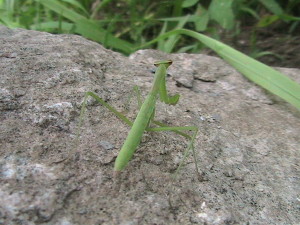
Young praying mantis scoping the area. You can tell that it doesn’t have wings yet which means it is not yet an adult.
These are very powerful and sneaky insects that are capable of blending in with its environment and can be either brown or green. The average adult is about two or three inches long, but some have been known to exceed four inches. Unlike other insects that have a larvae stage and an adult stage the praying mantis has just one. They start off small and as they grow they get bigger and will eventually get wings to help them travel larger areas. You can find nests on twigs or small branches which are about the size of a quarter or bigger.
How They Catch Their Prey
They are very good jumpers and have strong legs for jumping from plant to plant in order to catch their pray. They have incredible patience and will wait long periods of time in order to feast on a good meal. I have seen them pull carpenter bees right out of their nest and eat them within a matter of minutes. Once they get a hold of their meal they are not going anywhere because of the incredible strength of their claws.
The Advantages and Disadvantages of Praying Mantis
One of the best things about having praying mantis in your garden is that they can eat almost anything including caterpillars, predatory insects, flies, and moths. The bad thing about having them is that they are cannibals and will eat each other along with beneficial insects such as bees, lady beetles, ground beetles, butterflies, and many more.
You can purchase them commercially, but it wouldn’t be wise to do so because of their very large appetite for eating just about anything that is found in your garden. If you find them in your garden it is not necessarily a bad thing it is just important to be aware of the pros and cons of having them. Basically they are good and bad and you have to decide if they are helping or harming your garden.
Personally I keep them in the garden even though they might be feeding on beneficial insects. I have not found them to be a problem and are very interesting to watch especially if they are in the process of feeding or catching their prey.
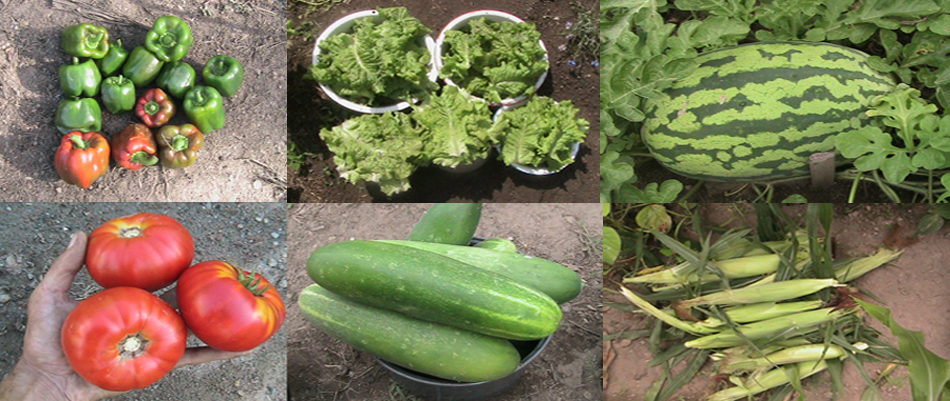
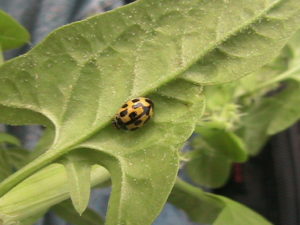
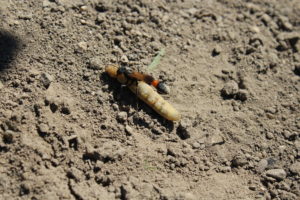
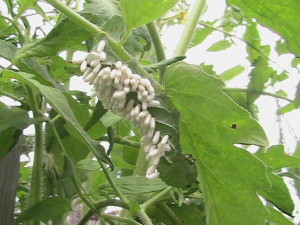
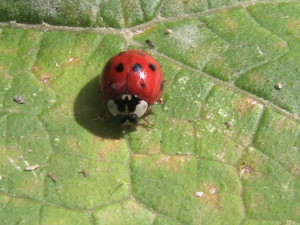

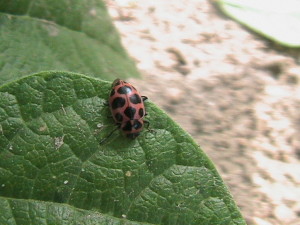

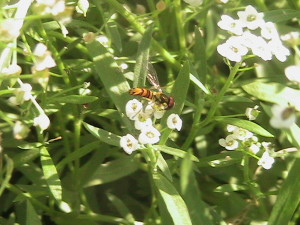
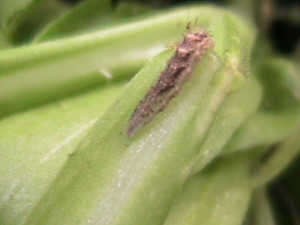
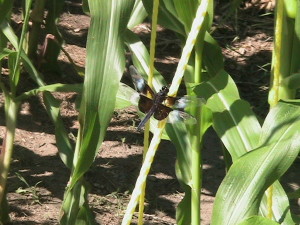
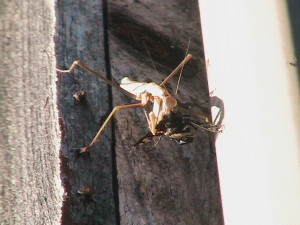
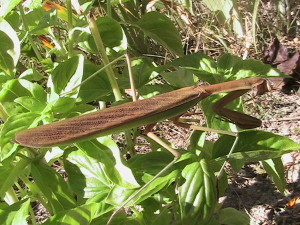

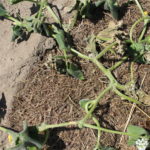

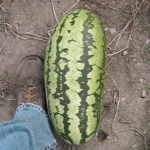
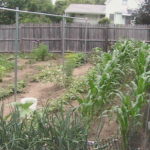
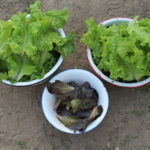
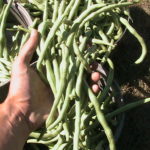
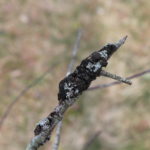
Recent Comments